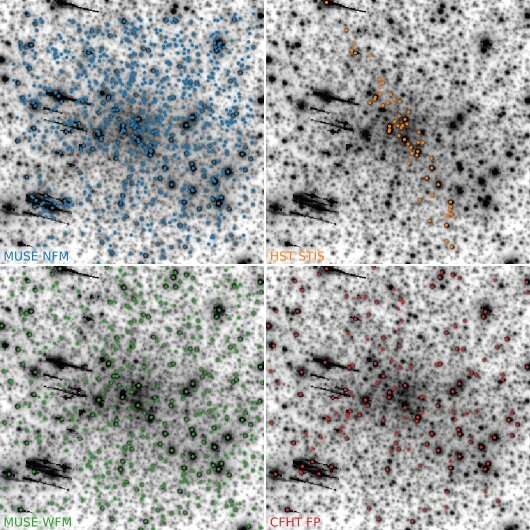
Using the Multi Unit Spectroscopic Explorer (MUSE), astronomers have performed observations of an old globular cluster known as Messier 15. The observational campaign delivered essential information about stellar kinematics of the central region of this cluster. The results were published February 24 on arXiv.org.
Globular clusters (GCs) are collections of tightly bound stars orbiting galaxies. Astronomers perceive them as natural laboratories enabling studies on the evolution of stars and galaxies. In particular, globular clusters could help researchers to better understand the formation history and evolution of early-type galaxies, as the origin of GCs seems to be closely linked to periods of intense star formation.
Located some 33,000 light years away from the Earth, Messier 15 (or M15, also known as NGC 7078) is a globular cluster discovered in 1746, estimated to be about 13 billion years old, which makes it one of the oldest GCs discovered to date. It is a metal-poor globular cluster with a radius of some 88 light years, mass of about 100,000 solar masses, and its steep, cuspy surface brightness profile indicates that it is a core collapse GC.
Previous observations of M15 were focused on the surprising detection of rotation in its central regions as one study identified a fast-spinning, kinematically decoupled core in the inner region (four arcseconds) of this GC. Another study found that the core of M15 shows a higher rotation and a different rotation axis than what is usually found at such large radii. In order to shed more light on this behavior, a team of astronomers led by Christopher Usher of the Stockholm University in Sweden, decided to employ the MUSE instrument on the Very Large Telescope (VLT).
"Using the new narrow field mode of MUSE, we have studied the central kinematics of the core collapse GC M15 in detail," the researchers wrote in the paper.
MUSE allowed the team to measure radial velocities of 864 stars within 8 arcseconds of the center of M15. This is so far the largest sample of radial velocities ever obtained for the innermost regions of this globular cluster.
In general, the study found that M15 showcases complex central kinematics, which is distinct from kinematics observed in the outer parts of the cluster. The rotation axis of the core of M15 turns out to be offset from the rotation axis of the bulk of the cluster.
The astronomers noted that such kinematically distinct cores (KDCs) like the one in M15 are found in the centers of some massive early-type galaxies and are usually thought to form due to mergers. However, mergers of GC are thought to be relatively rare; therefore, the authors of the paper look for other hypotheses that could explain the KDC in M15, such as post core-collapse oscillations.
"In a future work, we will use dynamical models to fit this kinematic data set. This will allow us to explore possible hypotheses for the peculiar kinematics of this cluster, including the transfer of angular momentum from black hole binaries and post core-collapse oscillations," the astronomers concluded.
© 2021 Science X Network
Citation: MUSE sheds more light on central kinematics of Messier 15 (2021, March 3) retrieved 3 March 2021 from https://ift.tt/3kSjvK9
This document is subject to copyright. Apart from any fair dealing for the purpose of private study or research, no part may be reproduced without the written permission. The content is provided for information purposes only.
"light" - Google News
March 03, 2021 at 09:10PM
https://ift.tt/3kSjvK9
MUSE sheds more light on central kinematics of Messier 15 - Phys.org
"light" - Google News
https://ift.tt/2Wm8QLw
https://ift.tt/2Stbv5k
Bagikan Berita Ini















0 Response to "MUSE sheds more light on central kinematics of Messier 15 - Phys.org"
Post a Comment